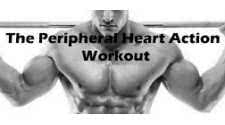Peripheral Heart Action Training System - PHA Workouts

Experiment with New Training Methods for New Results
PHA. Um, let's see. Potentially | Hazardous Asteroids? Or how about Pakistan Housing Authority? I have another one but I can't put it in writing where children might see.
No, PHA, developed more than 30 years ago by Bob Gajda, a former Mr. America (1966), stands for Peripheral Heart Action. Gajda was looking for a way to do set after set
with no rest in between, a little like super-setting your entire workout as a way to improve condition and trim bodyfat. Since summer is upon us, trimming a little body-fat
would be a good idea.
Gajda discovered that if you do sets for widely separated parts of the body, blood doesn't "stagnate" in one area. For instance, if you did consecutive sets of benches and
chins you'd fatigue and begin to fail sooner than if you did benches followed by squats, curls, crunches, presses, etc. A lot of people used the technique with great
success. Sergio Oliva was one proponent. If it was good enough for him, it's good enough for me.
Basically the program called for establishing groups of exercises consisting of five or six movements. You'd intentionally set up the exercises so that the bodyparts impacted
were distant from one another. Execute one set of each exercise in group one, like 1-2-3-4-5-6, then back to exercise one again, quite literally running from one to the next.
Here's a sample routine:
Group 1: squats, seated presses, calf presses, incline presses, pulldowns, crunchesGroup 2: curls, leg lifts, lateral raises, pressdowns, bent laterals, hyperextensions
Group 3: leg extensions, side bends, benches, leg curls, bent rows, seated calf presses.
Go through all of group one four or five times. Then do the same with groups two and three. That's a lot of sets, done with no rest. Typically you'd do this workout three times a week.
That's PHA. The disadvantages are numerous, as I'm sure you've already noticed. You'd better be the only guy in the gym during your workouts so that people don't get on your equipment. The late, great John McCallum actually recommended jogging in place until the piece of equipment you need is freed up. I think I have another solution that seems to work, kind of a new twist on PHA. I call it XPHA or extended PHA.
Instead of doing one set of each exercise, then moving to the next in the sequence, do multiple sets of each exercise but as an extended drop set. Begin the extended set with a moderate weight and stop well short of failure. As each "step" becomes a strain, reduce the weight and continue. Do four or five drops within each set, go to failure on the last drop, and then move to the next bodypart. Do fewer total movements in a group to reduce the odds of losing equipment. Also, you can kind of time your completion of a set. If someone grabs your equipment, you can time your set to finish when his does.
This system isn't foolproof, but it is fool-resistant. Try to choose exercises that allow for smooth weight changes. Squats and benches are out. Go with more machine and dumbbell choices. I try to mentally prepare for some flexibility in the exercises. If someone grabs the pec machine, the extended-set system allows me time to see I that and plan for a move to dumbbell benches instead.
There's a tremendous volumizing effect that's good for growth. Like conventional PHA, XPHA is not going to give you a vein-busting pump. Because it is drawing blood to constantly shifting bodyparts, the technique prevents the pooling effect necessary for a good pump. But no one has ever proven a pump is essential for growth.
XPHA burns fat and revs up the metabolism. In effect this is interval training, depending on how protracted the sets are, either in the phosphagen or glycolytic system. Technically these are anaerobic metabolic pathways, but done in this fashion they promote aerobic fitness very effectively. And they do it without the muscle-wasting associated with consistent high volumes of aerobic exercise. A bonus is that a number of studies have suggested this type of anaerobic training is superior to traditional aerobics for fat-burning.
You're not likely to hit a new max on your squat or bench with this approach. (You aren't doing them anyway.) This system is definitely for the cutting-up phase of your cycle. You may be surprised to see some new inches and improved shape (remember the volumizing effect I mentioned earlier?), but substantial increases in strength probably won't happen. However, for losing inches that are currently in the wrong places, you can't beat extended PHA.
Here's a sample routine:
Group 1: leg presses, seated dumbbell presses, crunches, pulldownsGroup 2: curls, leg lifts, pressdowns, seated calf presses
Group 3: leg extensions, cable rows, leg curls, pec-dek
Group 4: incline dumbbell presses, calf raises, dumbbell shrugs, hyperextensions
Because of the extended nature of the sets, instead of going through each group four or five times, I'd suggest three times. Then continue with each of the other groups. Look around your gym and put together a second set of four groups with different movements. Alternate the two sets of groups. The alternate set of groups could emphasize problem areas. Maybe every group in that second routine has a biceps movement in it somewhere. Whatever. Do the workout three times a week with pure cardio (running, speed walking, cycling, something like that) on your off-days. Remember to keep your diet clean. (You can sabotage any fat-loss routine by eating crap.) In no time at all you'll be ready for the beach.